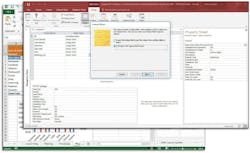Time for Transition
In the late 80s, New Jersey Siding and Windows took a big leap towards sophisticated data management—which at the time was not a pressing topic in the home improvement industry. The company hired someone to construct a custom Microsoft Access database to keep track of clients and sales. Migrating information from paper to the digital space was such an exhausting transition that the process wasn’t revisited for another two decades.
“We didn’t update our system again until 2017, and even then it was long overdue,” says Matt Sciacca, vice president at New Jersey Siding and Windows, his family’s business. “Our old system didn’t even have a space for recording clients’ email addresses.” The company now uses the CRM ImproveIt 360 and Salesforce, a sales management platform. “Switching over was painful, but absolutely necessary.”
Painful because the transition from any form of data management—whether scattered Post-it Notes or a custom Excel sheet—to a more modern, flexible, and increasingly necessary digital platform takes effort and time. It’s exactly the reason remodeler Abby Binder, who owns Abby Windows & Exteriors, hasn’t been able to make the big switch. That is until recently.
“[The early days of] the pandemic slowed things down,” says Binder. “Using that time to make that transition was great.”
Still, short on time or not, the process of adopting and building out new software systems can be challenging. To that end, we’ve collected a few tips to make the process easier.
1. Know What Data You Want To Track
Without an existing, somewhat organized system, knowing what data you want to keep tracking can be difficult. “Developers will give you templates to help you fill out the information,” says Binder, who uses multiple systems including QuickBooks, MarketSharp, and Grasshopper. “But often you’ll have to build out the backend yourself. It’s a good idea to know what existing data is where to make inputting it easier.”
The “backend” refers to the guts of any software system. For instance, a CRM like MarketSharp—which tracks leads, schedules appointments, automates workflows, etc.— can’t properly function without, say, client names, phone numbers, email addresses and the entire breadth of data to give the system context. MarketSharp’s creator and current director of business development Tim Musch says that in many cases a CRM won’t work to its fullest potential if the remodeler doesn’t know what data they want to track. This is because the customization to the company will be limited. “A lot of remodelers track additional KPIs and that requires extensive customization,”Musch says. “Developers can work with you but they need to first know the data.”
2. Check For Importability, And Then Typos
When Matt Sciacca was helping New Jersey Siding and Windows transition to Salesforce, he asked the developer if any data was importable. “It was,” he says. “But not all of it.”
With custom systems like Sciacca’s database and also with systems constructed in Excel and more increasingly Google Sheets, it’s likely that at least a portion of the data will be importable to a more modern system. Musch says that a lot of programs these days, including MarketSharp, have the ability to not only import a remodeler’s data but also to automatically organize it. However, with a more custom system, which is commonplace in remodeling, the data being tracked may not have an existing, dedicated space in the program being purchased. “It’s a good idea to have a conversation with the developer, because they may be able to help build custom tracking for the unique metrics a remodeler is already tracking,” Musch says.
It’s also a good idea to check the data itself before importing, Sciacca says. The rules that guide importing data are often delicate, with little ability to account for mistakes. “A lot of the data we tried to import to Salesforce wouldn’t go through because we’d forgotten a dollar sign or had written something incorrectly,” Sciacca says. “It would’ve been smoother to have thoroughly checked for those errors beforehand.”
3. Ask About Integrations And Integration Building
Most remodelers don’t use just one software system. There are CRMs, sales management programs, finance tools, production tools, design tools, and the list goes on. Plenty are worth adopting but not all work together. “A reason we’ve been so careful about buying new software is that we want to make sure the systems talk to each other,” says Binder.
A challenge specific to integrating is not all software systems advertise their compatibility with other softwares. Musch recommends that remodelers make a list of all the systems used in their business, including apps specific to building products, and ask developers directly. “Even if integrations aren’t currently available, if there is enough interest in making that bridge, some developers will create a new integration for that business.”
4. Back Up Your Data Before You Transition
A big risk in moving data to a new system, and particularly older data, is it’s possible that the information has been corrupted and you don’t even realize it. “We lost all of the product information for our clients in our transition because it was corrupted, and we didn’t have it backed up,” Sciacca says. “We know if it was a siding or a window sale, but what kind of siding or window we lost.”
He says that information is especially important these days because people are more specific in their preferences. “Now we keep copies of everything.”
RESOURCES
Financial
Quickbooks: https://quickbooks.intuit.com/online/integrations/
Sales and Marketing
Apex Chat: https://www.apexchat.com/integrations/
ConstantContact: https://marketplace.constantcontact.com/AppsSearch?attribute=none&industry=none&need=none&query=&sort=featured
Leap: https://leaptodigital.com/partners/#leapPartnerBar
Customer Management and All-in-One Software
MarketSharp: https://www.marketsharp.com/apps-and-integrations/ ImproveIt 360: https://www.improveit360.com/partners-and-affiliates/
JobNimbus: https://www.jobnimbus.com/integrations/
OneClickContractor: https://oneclickcontractor.com/solutions/integrations/
SalesRabbit: https://www.salesrabbit.com/integrations Salesforce: https://www.salesforce.com/solutions/small-business-solutions/integrations/#!page=1
Production Management
CoConstruct: https://www.coconstruct.com/pricing
Measuring Tools
EagleView: https://www.eagleview.com/system-integrations/#:~:text=EagleView%20property%20data%20integrates%20easily,Accurence%20Scope%20Assist&text=AccuLynx
Hover: https://help.hover.to/en/articles/2599328-integrations-overview




